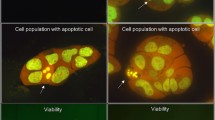Abstract
Mouse teratocarcinoma stem cells deficient in activity of adenine phosphoribosyltransferase (APRT; EC 2.4.2.7) were obtained in order to have this marker in developmentally versatile cells. Mutagenized stem-cell cultures were selected for resistance to 8-azaadenine and four clonal cell lines were isolated. Three had severe deficiencies of APRT activity (7% or less of wild type) and one had a moderate reduction (73%). The enzyme in the latter clone was found to be an electrophoretic variant with slightly less anodal migration than the wild-type enzyme. Each clone remained stably APRT-deficient for at least 3% weeks, after subcutaneous inoculation, in the absence of the selective agent. The tumors formed from the inocula comprised a variety of differentiated tissues and thus showed persistence of stem-cell developmental pluripotency despite mutagenesis and selection. All mutants also retained the quasinormal karyotype (X/0 sex chromosomal constitution, trisomy-19) of the parent line. These lines are appropriate for such uses as production (by blastocyst injection) of mouse models of the human genetic deficiency and for foreign-gene transfer, via teratocarcinoma cells, into mice.
Similar content being viewed by others
Literature cited
Stevens, L. C. (1967).Adv. Morphog. 6:1–31.
Pierce, G. B. (1967). InCurrent Topics in Developmental Biology, Vol. 2, (eds.) Moscona, A. A., and Monroy, A. (Academic Press, New York), pp. 223–246.
Kleinsmith, L. J., and Pierce, G. B., Jr. (1964).Cancer Res. 24:1544–1551.
Mintz, B., and Illmensee, K. (1975).Proc. Natl. Acad. Sci. U.S.A. 72:3585–3589.
Illmensee, K., and Mintz, B. (1976).Proc. Natl. Acad. Sci. U.S.A. 73:549–553.
Cronmiller, C., and Mintz, B. (1978).Dev. Biol. 67:465–477.
Mintz, B., and Cronmiller, C. (1978).Proc. Natl. Acad. Sci. U.S.A. 75:6247–6251.
Finch, B. W., and Ephrussi, B. (1967).Proc. Natl. Acad. Sci. U.S.A. 57:615–621.
Kahan, B. W., and Ephrussi, B. (1970).J. Natl. Cancer Inst. 44:1015–1036.
Mintz, B. (1977). InGenetic Interaction and Gene Transfer, Brookhaven Symposia in Biology, Vol. 29, (ed.) Anderson, C. W. (Brookhaven Nat. Labs., Upton, New York), pp. 82–95.
Mintz, B. (1978). InCell Differentiation and Neoplasia, (ed.) Saunders, G. F. (Raven Press, New York), pp. 27–53.
Mintz, B. (1978).Harvey Lect. 71:193–246.
Mintz, B. (1979). InModels for the Study of Inborn Errors of Metabolism, (ed.) Hommes, F. A. (Elsevier/North-Holland, Amsterdam), pp. 343–354.
Dewey, M. J., Martin, D. W., Jr., Martin, G. R., and Mintz, B. (1977).Proc. Natl. Acad. Sci. U.S.A. 74:5564–5568.
Seegmiller, J. E. (1976).Adv. Hum. Genet. 6:75–163.
Cartier, P., and Hamet, M. (1974).C.R. Acad. Sci. Paris 279:883–886.
Simmonds, H. A., Van Acker, K. J., Cameron, J. S., and Snedden, W. (1976).Biochem. J. 157:485–487.
Debray, H., Cartier, P., Temstet, A., and Cendron, J. (1976).Pediatr. Res. 10:762–766.
Van Acker, K. J., Simmonds, H. A., Potter, C., and Cameron, J. S. (1977).N. Engl. J. Med. 297:127–132.
Barratt, T. M., Simmonds, H. A., Cameron, J. S., Potter, C. F., Rose, G. A., Arkell, D. G., and Williams, D. I. (1979).Arch. Dis. Child. 54:25–31.
Jakob, H., Boon, T., Gaillard, J., Nicholas, J. F., and Jacob, F. (1973).Ann. Microbiol. (Inst. Pasteur)124B:269–282.
Guénet, J. L., Jakob, H., Nicolas, J. F., and Jacob, F. (1974).Ann. Microbiol. (Inst. Pasteur)125A:135–151.
Kusano, T., Long, C., and Green, H. (1971).Proc. Natl. Acad. Sci. U.S.A. 68:82–86.
Nichols, E. A., and Ruddle, F. H. (1974).Cytogenet. Cell Genet. 13:132–135.
Welshons, W. J., and Russell, L. B. (1959).Proc. Natl. Acad. Sci. U.S.A. 45:560–566.
White, B. J., Tjio, J.-H., Van de Water, L. C., and Crandall, C. (1974).Cytogenet. Cell Genet. 13:217–231, 232–245.
Kozak, C., Nichols, E., and Ruddle, F. H. (1975).Somat. Cell Genet. 1:371–382.
Epstein, C. J. (1972).Science 175:1467–1469.
Chapman, V. M., and Shows, T. B. (1976).Nature 259:665–667.
Watanabe, T., Dewey, M. J., and Mintz, B. (1978).Proc. Natl. Acad. Sci. U.S.A. 75:5113–5117.
Jones, G. E., and Sargent, P. A. (1974).Cell 2:43–54.
Chasin, L. A. (1974).Cell 2:37–41.
Siminovitch, L. (1976).Cell 7:1–11.
Van Diggelen, O. P., Donahue, T. F., and Shin, S.-I. (1979).J. Cell. Physiol. 98:59–71.
Chu, E. H. Y., and Powell, S. S. (1977).Adv. Hum. Genet. 7:189–242.
Liskay, R. M., and Patterson, D. (1979).Cytogenet. Cell Genet. 23:61–69.
Wigler, M., Pellicer, A., Silverstein, S., Axel, R., Urlaub, G., and Chasin, L. (1979).Proc. Natl. Acad. Sci. U.S.A. 76:1373–1376.
Author information
Authors and Affiliations
Rights and permissions
About this article
Cite this article
Reuser, A.J.J., Mintz, B. Mouse teratocarcinoma mutant clones deficient in adenine phosphoribosyltransferase and developmentally pluripotent. Somat Cell Mol Genet 5, 781–792 (1979). https://doi.org/10.1007/BF01542641
Received:
Issue Date:
DOI: https://doi.org/10.1007/BF01542641




